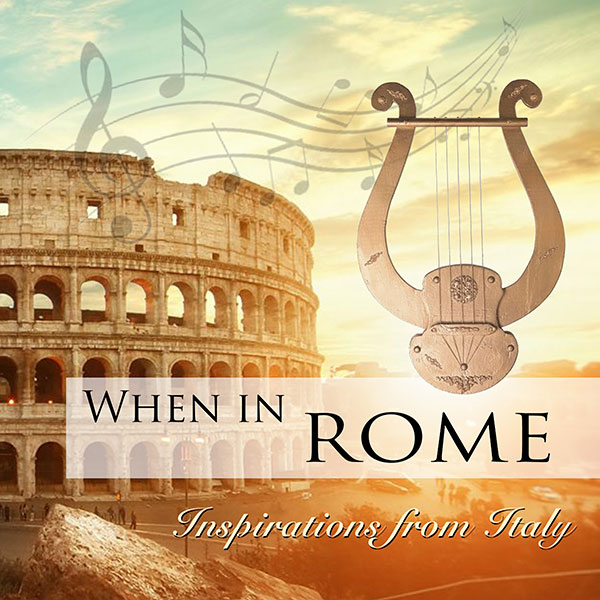
Concert 1
When in Rome… Inspirations from Italy
October 6, 2022 at 7:30 PM
October 5, 2022 – Children’s Concerts
Cailloux Theater – Kerrville, Texas
Mendelssohn – Symphony No. 4 in A Major, Op. 90 Italian
Respighi – Pines of Rome
Gershwin/Balentine – Suite from Porgy & Bess for violin and orchestra
Nicole Cherry, violin soloist
The opening concert of the 2022-2023 season celebrates the spirit of Rome, Italy, and all the history and accomplishments of its citizens and guests. The saying, “when in Rome, do as Romans do” captures the thrill and risk of learning and adopting new customs when in unfamiliar territory.
Our centerpiece is the Symphony No. 4 by Felix Mendelssohn. During a tour of Italy and Europe, Mendelssohn was inspired by Italian places and culture when he composed this exciting work to share the energy he felt there.
George Gershwin was an American composer who brought the under-represented stories and music of African Americans to this beautiful opera which has become popular all over the world. San Antonio composer James Balentine was commissioned to arrange Gershwin’s music for solo violin and orchestra by former Symphony of the Hills concertmaster, Daniel Kobialka. This performance features UTSA violin professor Nicole Cherry, an internationally known violinist and member of the Marian Anderson String Quartet, performing Porgy & Bess.
The concert concludes with the march-like fanfare of Italian composer Ottorino Respighi’s The Pines of Rome. You will feel the power of the Roman Empire in this masterpiece of orchestral repertoire. This performance will also be presented to community children through the symphony’s Children’s Adventures in Music.
 Dr. Nicole Cherry is Assistant Professor of Violin at The University of Texas at San Antonio and second violinist of the award-winning Marian Anderson String Quartet. Dr. Cherry has held artist-teacher residencies at Texas A&M, Prairie View A&M, University of Washington, and Brown University where she, with the quartet, trained promising string players of all ages. Dr. Cherry has performed extensively in distinguished venues including the Library of Congress, the Kennedy Center, Lincoln Center, Carnegie Hall, the Smithsonian, and the Banff Centre. A solo tour of the Middle East and Asia included performances before the Queen Noor of Jordan and in underdeveloped townships in Johannesburg during Apartheid.
Dr. Nicole Cherry is Assistant Professor of Violin at The University of Texas at San Antonio and second violinist of the award-winning Marian Anderson String Quartet. Dr. Cherry has held artist-teacher residencies at Texas A&M, Prairie View A&M, University of Washington, and Brown University where she, with the quartet, trained promising string players of all ages. Dr. Cherry has performed extensively in distinguished venues including the Library of Congress, the Kennedy Center, Lincoln Center, Carnegie Hall, the Smithsonian, and the Banff Centre. A solo tour of the Middle East and Asia included performances before the Queen Noor of Jordan and in underdeveloped townships in Johannesburg during Apartheid.
Dr. Cherry served as artistic director of the Marian Anderson String Quartet Chamber Music Institute held in the underserved areas of Brazos Valley, Texas. In recognition of this outreach with the quartet, Dr. Cherry garnered two Mayoral Proclamations, the Congress of Racial Equality’s MLK JR. Award for Outstanding Arts Achievement and Chamber Music America’s Guarneri String Quartet Award. A regular presenter on diversity and music, Dr. Cherry has given talks at the some of the leading arts conferences as well a TED Talk on community engagement and music.
Dr. Cherry’s award-winning research on the nineteenth-century Afro-European violin virtuoso, George Bridgetower, which explores historical socio-cultural theories in music has led to performances in some of world’s most prestigious institutions including University of Pennsylvania, Sydney Conservatory of Music (AU), Cambridge University (UK) and the Juilliard School (NY). Her work has expanded into a commissioning project, ForgewithGeorge which has engaged some of today’s most exciting composers. The Juilliard School profiled Dr. Cherry in the Journal’s 100th-anniversary issue, “A Quiet Revolution: Juilliard Alumni and the Transformation of Education in America Through the Arts.”
Program Notes
Felix Mendelssohn – Symphony No. 4 in A Major, Op. 90 Italian 30 m
A composer with a solid anchor in the classical tradition and also lyrical Romantic instincts, Felix Mendelssohn (1809-1847) is often seen as the last of three German musical geniuses (following Mozart and Schubert) whose overlapping lives were all too brief. Like Mozart, Mendelssohn, though blessed with a prosperous family, showed his talents at an early age. He valued and seemed able to assimilate music of his predecessors while retaining his own voice. At the age of 20, having received a copy of the work, he conducted a production of Bach’s St. Matthew Passion, helping stimulate a reappreciation of the earlier master.
Mendelssohn composed in many forms, from solo piano pieces (his famous Songs Without Words, which became standard recital works throughout the nineteenth century), to chamber works, concerti, oratorios, and symphonies. He was also an accomplished pianist and deeply involved in musical education. A lover of travel (he made eight trips to Britain in his short life), he could find inspiration in different climes. A visit to Italy prompted his Symphony #4, which he described to his sister Fanny as his “jolliest.”
Rome and the Campagna region clearly spoke in both energetic and reflective tones to Mendelssohn, with the former dominating the first and fourth movements and the latter the second and third. The Fourth Symphony was first performed in England, when the composer was asked for a symphony and proceeded to complete the fourth. Interestingly, Mendelssohn was not satisfied with the composition and reworked it in his last years. It has satisfied many listeners, however, over time.
Gershwin/Balentine – Suite from Porgy & Bess for violin and orchestra 12 m
Nicole Cherry, violin soloist [This work was commissioned by Daniel Kobialka]
American composer George Gershwin (1898-1937) is claimed by both popular and classical traditions, and few will dispute that in his short lifetime he contributed generously to both, even effecting a crossover between jazz and the classical tradition in works such as “Rhapsody in Blue” and “Concerto in F.” One of his most beloved works is the folk opera “Porgy and Bess,” based on DuBose Heyward’s novel. The music of Catfish Row may seem some distance from Rome, but it offers a lovely transition to home ground between our Roman-inspired works. Besides, we all know that “when in Rome, do as the Romans do,” and all Italians respond to beautiful melody.
This evening’s version is a special one and closely related to your Symphony. It was commissioned by our late Concertmaster Daniel Kobialka for violin and orchestra and arranged by James Scott Balentine, composer of musical pieces for diverse ensembles. We are privileged to have Dr. Nicole Cherry of UTSA to perform as violin soloist.
Ottorino Respighi – Pines of Rome 22 m
Born and reared in Bologna, Respighi (1879-1936) benefited from the support of a musical family. He had a scholarly bent that extended beyond music, learning eleven languages and reading avidly in them. After early training, he spent a season in 1902 as principal violist in the Imperial Orchestra of St. Petersburg, where he received valuable training in composition from Rimsky-Korsakov. Returning to Bologna to complete his formal studies, and broadening them in Germany, Respighi launched into a career as a professor, chamber performer and composer.
Respighi’s three tone poems, “Fountains of Rome,” “Pines of Rome,” and “Roman Festival,” composed from 1916 through 1928, are his most famous and treasured works. They illustrate his power with tone color, suggestive of the influence of Rimsky-Korsakov. “Pines of Rome” takes us around the city and its surroundings, carrying us both through the day and also back through history. Respighi moves through his four “locations” without pause, creating a sense of flow, though tone and tempo vary greatly. Beginning with the shimmering picture of children at play in the Borghese Gardens, he descends literally and historically into the catacombs, then into the quiet of evening atop the Janiculum Hill, softened by the literal song of the nightingale, and finally to the ancient thoroughfare, the Appian Way, where Roman legions entered the city.
The Roman tone poems established Respighi’s reputation among Italian composers of the 20th century. They convey his gift for musical visual portrayal, as also apparent in his evocation of three paintings by Sandro Botticelli. Respighi was drawn to past musical and artistic cultures, and transcribed much music from earlier centuries, such as his popular reworking of 16th century lute melodies in “Ancient Airs and Dances.” He collaborated on a number of ballet productions of his own time as well.

